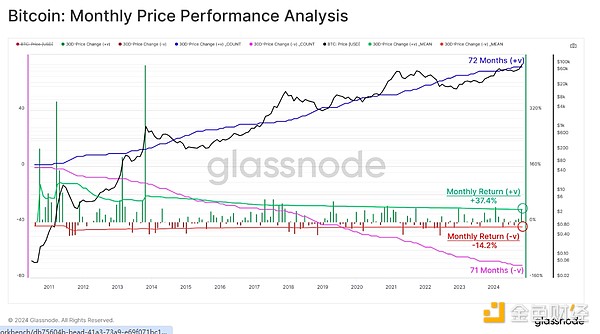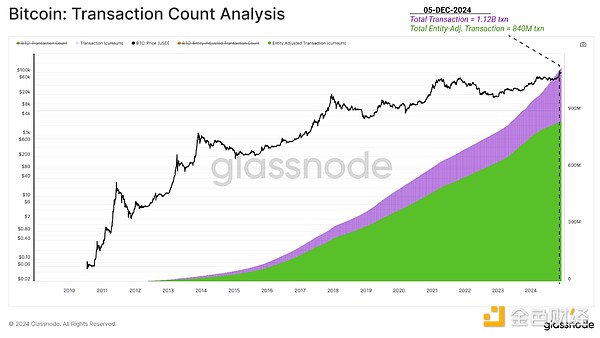Author: CryptoVizArt, UkuriaOC, Glassnode; Compiled by: Tong Deng, Jinse Finance
Abstract
On December 5th, the price of Bitcoin broke through the $100,000 milestone for the first time after 5,256 trading days, and its market capitalization briefly exceeded $2 trillion.
Since its inception, miners have accumulated a total revenue of $71.49 billion, reflecting the network's robust security and economic incentives.
The network has processed 1.12 billion transactions and settled $131.25 trillion in transfer volume, with the on-chain data adjusted for entities providing a clearer picture of the actual economic activity.
The granular breakdown of supply held by different groups highlights the broad distribution of Bitcoin ownership, from retail investors to institutional-scale holders.
This article reviews Bitcoin's extraordinary journey from the Genesis Block to the breakthrough of $100,000 per BTC. On December 5th, Bitcoin reached this milestone for the first time.
This report explores the evolution of the Bitcoin network and its economic foundations, tracing the incredible path from zero to this breakthrough achievement.

Market Expansion
Bitcoin's trading price has been active for 5,256 days, rising from a few cents to $100,000. This journey includes 72 positive monthly candles (including December 2024), with an average gain of 37.4%, and 71 negative monthly candles, with an average decline of -14.2%.
This reflects the captivating balance between bull and bear markets, as well as the notorious positive skewness during the most severe price appreciation periods.

As of December 5th, a total of 19,791,952 BTC have been mined, accounting for 94.2% of the final 21 million supply cap. Bitcoin's market capitalization also briefly surpassed $2.0 trillion and convincingly exceeded the market value of the precious metal silver (around $1.84 trillion).

During this extraordinary market expansion period, investors have realized $1.27 trillion in profits and $-592 billion in on-chain losses (based on the difference between acquisition price and disposal price). This has resulted in a cumulative net capital inflow (realized market value) of $750 billion, highlighting the immense value that has flowed into the Bitcoin network over its lifetime.

Supply Distribution
The distribution of the total mined Bitcoin supply among different wallet size groups is as follows:
<0.001 BTC: 5,491 BTC (0.027%)
0.001–0.01 BTC: 42,683 BTC (0.216%)
0.01–0.1 BTC: 271,641 BTC (1.373%)
0.1–1 BTC: 1,077,839 BTC (5.446%)
1–10 BTC: 2,093,845 BTC (10.581%)
10–100 BTC: 4,306,780 BTC (21.761%)
100–1,000 BTC: 4,342,868 BTC (21.935%)
1,000–10,000 BTC: 4,693,216 BTC (23.716%)
10,000–100,000 BTC: 2,309,654 BTC (11.671%)
>100,000 BTC: 647,934 BTC (3.274%)
Notably, the majority of these large wallets (holding 1000+ BTC) are associated with exchanges, ETFs, and large institutional entities like MicroStrategy. Each of these large entities represents the collective ownership of thousands to millions of clients and shareholders.

As of December 5th, notable total balances include 1.8 million BTC held by exchanges (9.1% of supply) and 1.1 million BTC managed by US ETFs (5.6% of supply), with significant growth since their launch on January 11, 2024. Additionally, miners (excluding Patoshi) hold a balance of 0.7 million BTC (3.5% of supply), while the US Treasury holds 0.187 million BTC (0.9% of supply), reflecting the broad distribution of ownership among different entities.
These balances also highlight the increasing institutionalization and centralization of Bitcoin custody, balancing individual ownership with larger total holdings that drive liquidity and market stability.

Network Evolution
Next, we will focus on the evolution of the Bitcoin network, tracing Bitcoin's journey from its inception as a system for transferring financial value. We will explore the milestones, technological advancements, and adoption trends that have transformed Bitcoin from an experiment into a global financial phenomenon, paving the way for its $100,000 price milestone.
Since the Genesis Block, a total of 873,304 blocks have been mined, with Bitcoin's average block time of 11.8 minutes reaching the historic price of $100,000 on December 5, 2024. While the contemporary average block interval is faster, around 9.6 minutes, due to increased hash rate, the early years saw a slower start, as Satoshi Nakamoto had overestimated the performance of desktop CPU relative to the initial difficulty setting.

During the same period, the network difficulty (a measure of the computational work required to mine a block) has increased dramatically. After 418 difficulty adjustments (excluding unadjusted periods), the network difficulty has grown to 446,331,432,498,125,300,000,000, as the security and computational power behind Bitcoin have continuously strengthened.

The difficulty adjustment target in Bitcoin's Proof-of-Work (PoW) consensus is to mine a block approximately every 10 minutes, regardless of how the network hash rate changes. It dynamically adjusts the mining difficulty every 2,016 blocks (about 2 weeks) to maintain consistency with the 600-second target block time.
As Bitcoin reached $100,000, the network hash rate has soared from 128,185 hashes/second to over 804,407,834,059,443,100,000 hashes/second. To date, miners have cumulatively computed approximately 5.01 x 10^28 hashes, with a notable 37% of the total hash value occurring in 2024 alone.

As of December 5th, the cumulative revenue earned by miners is $71.49 billion, with the value of block rewards calculated based on the day of block extraction. This revenue includes $67.31 billion in block subsidies from minting new coins and $4.18 billion in transaction fees paid by users. This represents only 3.57% of Bitcoin's $2 trillion market capitalization peak, reflecting the enormous return on the security budget investment.

Bitcoin's transaction volume has also seen remarkable growth. To date, the network has successfully processed 1.12 billion transactions (unfiltered).
The entity-adjusted heuristic approach of glassnode integrates the activity between addresses that are considered to be controlled by the same entity (such as an ETF or exchange). This can filter out internal transfers and provide a clearer understanding of the actual economic activity happening on-chain.
Using our entity-adjusted total transaction count variant, we can filter out around 280 million internal transactions, with the actual economic transaction count for BTC standing at 840 million to date.

Calculated by the dollar value of transactions at the time of confirmation, the Bitcoin network has cumulatively processed $132.25 trillion in transaction volume. Applying entity adjustment, the filtered transfer volume is $11.63 trillion, only 8.86% of the total.
This reflects that most transaction counts are essentially economic in nature. However, the vast majority of the transfer volume on-chain is likely related to the management of large exchanges and custodial wallets.

Summary
Bitcoin's journey to reach $100,000 per BTC not only symbolizes a price milestone, but also demonstrates its extraordinary journey from a small corner of the internet to a globally significant financial infrastructure. Since the genesis block, the network has made tremendous progress, reaching a market capitalization of $2 trillion, surpassing silver, and settling $132 trillion in transaction volume through 1.12 billion transactions.
The network has paid a cumulative value of $71.49 billion to miners, just over 3% of its market capitalization, to support its own input costs, reflecting an incredible return on investment. With its hash rate near historical highs and a highly decentralized holder base, Bitcoin is playing an increasingly important role on the world stage.







